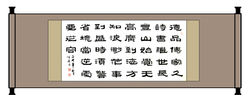

Art Green Island

请选择语言
About Mounting and Matting Chinese Art
Junrui Garcia
As the saying goes, “three-point art and seven-point mounting and matting”. It precisely describes the mounting & matting’s significance for Chinese art. Different from artworks were painted on prepared canvas, linen, wood or walls such as oil painting, mural and so on, Chinese calligraphy and painting are painted on very thin and soft rice paper or silk. The colors must be mixed with water. Inevitably this process creates uneven and irregular wrinkles on the rice paper or silk which makes the painting quality totally different from what the artist was intended to have. Thus while finishing painting, many calligraphers and painters always try to comfort themselves by saying “This, well … it’s going to be fine when it gets mounted and matted.”
Among below, the up left picture is a calligraphy work by Shunxiang Chang which is unmounted.
Mounting firstly adds thickness to the artwork. Meanwhile, both the ink and color could be permeated into the paper and appear the best effect on the mounting paper. Secondly using brocade or damask in appropriate layout, the matting would bring new life to the artwork.
There are various forms of mounting and matting. According to the layout and the ways people viewing, the artworks have landscape scroll, portrait scroll, flat for frame, hand scroll, cut and inlaid, album. Each type can use different designs on the matting area.
In addition, single color, dual color or trichromatic techniques are applied according to the consumers’ preferences as showing below.
 Unmounted calligraphy |  Landscape layout |  Hand scroll |
|---|---|---|
 Flat to frame |  Cut and inlaid - Circle |  Cut and inlaid - Fan shaped |
 Portrait layout matting |  Different colored |




